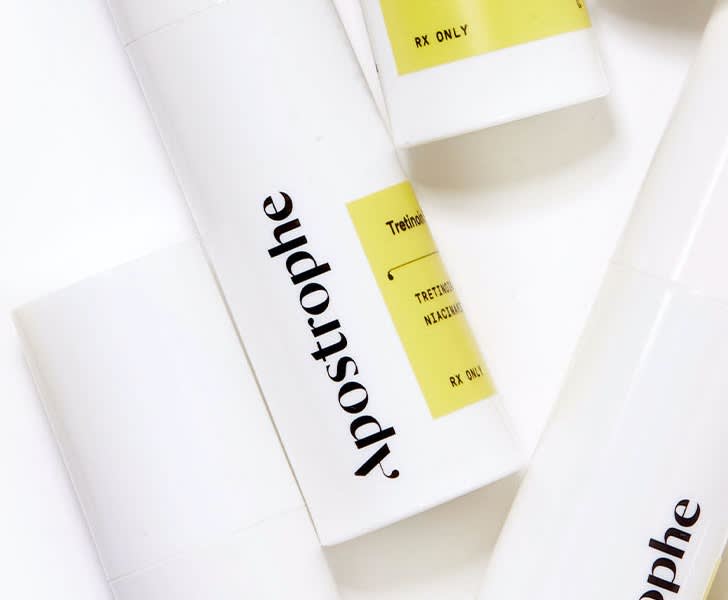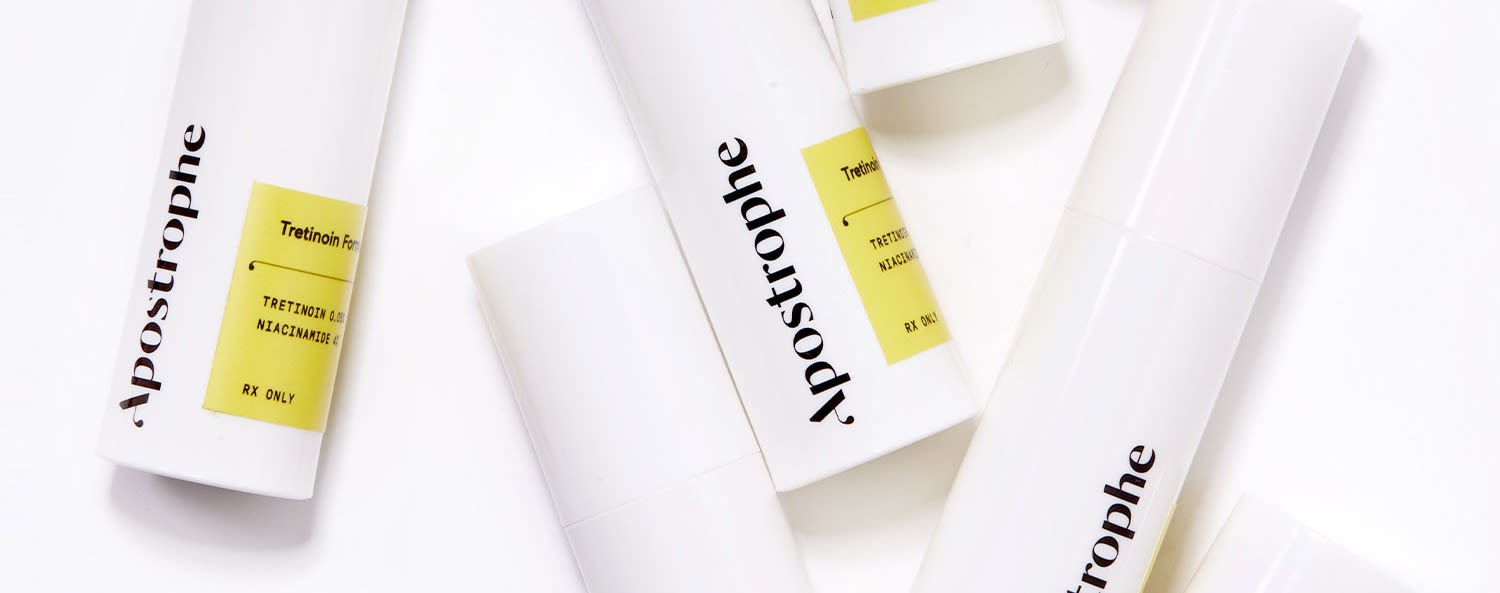Education
Tretinoin (Retin-A) for Treating Cystic Acne: How and Why it Works


SHARE
Education
Tretinoin (Retin-A) for Treating Cystic Acne: How and Why it Works
Medically reviewed by Michele Emery, FNP
Written by Apostrophe Team
Last updated 4/1/2024
Cystic acne is the most severe type of acne — a form of acne that involves breakouts of red, infected, inflamed and painful pimples that can develop deep inside your skin.
Many people with cystic acne find that it’s persistent, with outbreaks of cystic acne sticking around for years at a time even with over-the-counter acne treatments.
Luckily, there are several options available for treating and preventing cystic acne. In this guide, we’ll look at how tretinoin — a topical retinoid that’s widely used as an acne treatment — may help you get control over your cystic acne outbreaks and prevent acne for the long term.
How Tretinoin Works as an Acne Treatment
Tretinoin is a topical retinoid — a derivative of vitamin A that’s widely used in skincare. It works by speeding up the rate at which your body replaces old skin cells with new ones — a process that’s referred to as skin cell turnover.
By increasing your body’s skin cell turnover speed, tretinoin helps the newer, lower layers of the epidermis make their way to the surface. You can almost think of it as a fast-forward button that helps your body refresh your skin more frequently than it normally would.
Tretinoin prevents acne by helping your body get rid of old skin cells, which can become trapped inside hair follicles with oil, at a faster pace. This makes it less likely that you’ll develop acne due to sebum (oil) and skin cell buildup.
Our guide to using tretinoin for acne prevention goes into more detail about the entire biological process behind tretinoin. On the whole, regular use of tretinoin over time may help keep skin fresh and clear, significantly reducing the risk of developing whiteheads and blackheads on your face.

PRESCRIPTION TRETINOIN
Target acne, dark spots, and signs of aging with this science-backed ingredient.
This is supported by research.
One study, from 2009, analyzed the efficacy of standard .05 percent tretinoin gel and .1 percent tretinoin gel microsphere (essentially a slow release tretinoin gel). At the end of the 12-week study, which included 1,537 participants, researchers concluded that both the standard tretinoin gel and the tretinoin gel microsphere significantly reduced inflammatory and noninflammatory lesions vs the placebo group.
And another study from 2015 looked at tretinoin mixed with an oral antibiotic — in the study’s case, clindamycin. At the end of the 12-week study, researchers found that a mix of of tretinoin and clindamycin reduced acne by from 13.70 ± 4.80 to 1.30 ± 2.95, respectively.
Cystic Acne vs. Regular Acne
Cystic acne is a severe form of acne. While regular acne develops when a hair follicle becomes clogged with a mixture of oil and dead skin, cystic acne forms when a clogged hair follicle becomes infected with bacteria.
When bacteria makes its way inside the follicle, it can cause inflammation. Infected pimples can become red, swollen and filled with pus. They may become itchy, irritated and can be painful if accidentally bumped or touched.
Worse yet, cystic acne can spread easily. If one infected pimple bursts, the bacteria can easily get stuck under your fingernails or trapped inside other hair follicles, causing a major outbreak elsewhere on your face or body that can affect your skin for months at a time.
Just like regular pimples, cystic acne is most common in teenagers and people in their early- to mid-twenties. However, it can affect people of all ages, and in adults it’s called adult-onset acne.
Does Tretinoin Treat Cystic Acne?
While there aren’t any studies that specifically look at tretinoin as a treatment for cystic acne, tretinoin is widely used and thoroughly studied as a conventional acne treatment. It’s also a widely prescribed medication by doctors for treating cases of cystic acne.
Because cystic acne is caused by a combination of acne and bacteria, most doctors use two medications as part of a treatment program: a retinoid (such as tretinoin, or in cases of severe or persistent cystic acne, isotretinoin) in conjunction with an antibiotic to help reduce inflammation and kill bacteria.
On its own, tretinoin does not kill bacteria, meaning that, while it’s effective in combination with an antibiotic, it’s usually not enough to completely treat cystic acne independently.
Some common antibiotics used in combination with tretinoin to treat cystic acne are tetracycline antibiotics like doxycycline, minocycline, and tetracycline. Some doctors also prescribe topical antibiotics like clindamycin and erythromycin, particularly for young patients.
Our guide to prescription acne medication goes into more detail about the medications used to treat severe, recurring cystic acne. On the whole, doctors often recommend a combination of tretinoin (or a similar topical or oral retinoid) and an antibiotic.
For most people, antibiotics are prescribed for a short period of time to kill bacteria and clear up cystic acne, while tretinoin is usually prescribed for long-term acne treatment and prevention.
It’s important to remember that everyone is different, meaning that a cystic acne treatment or prevention protocol you see listed online might not necessarily be the best option for you. To learn about the best option for treating your acne, talk to an experienced healthcare professional.
How to Use Tretinoin as an Acne Treatment
Tretinoin is a topical medication that’s typically sold as a cream, gel, or in rare cases, liquid solution. To use it, all you need to do is apply it to your clean, dry face once daily (typically shortly before bedtime) — there’s no need to worry about oral tablets, capsules or anything else.
Our guide to using tretinoin for acne treatment and prevention covers everything you need to know about using tretinoin to treat acne, including a step-by-step guide to applying tretinoin cream, gel or solution to your face.
Learn More About Tretinoin
Are you interested in treating your acne using tretinoin? Affordable and effective, tretinoin has been widely used as an acne and anti-aging treatment for several decades.
Our Tretinoin 101 guide covers all of the basics about tretinoin, from its origins as an acne and anti-aging medication to common brand names, uses and more. You can also learn more about the potential side effects of tretinoin in our guide to common and uncommon side effects.
Shop this post

Tretinoin
Like what you just read? Sign up for our email list to get the scoop on skincare science delivered straight to your inbox.

Education
What is milia?
What is milia? Today, we’re jumping into one type of bump that you may have heard about most commonly in infants — milia.
Read More
Education
Best moisturizer for acne-prone skin
If you have combination acne-prone skin, figuring out which moisturizer is best for your skin might be tough. In this guide, we break down the best moisturizer for combination, acne-prone skin.
Read More
Education
How to build a face care routine
As you get into skincare, it might seem overwhelming, especially trying to figure out the order you're supposed to apply products in. Below, we detail how to build a face care routine for your skin!
Read More